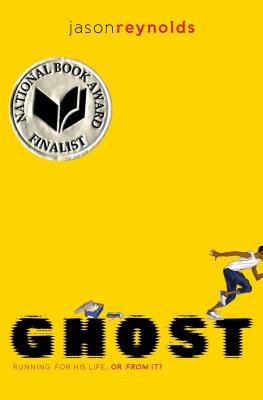Summertime at KidLitCraft means taking a pause and soaking up some of our favorite posts from days past. We will still be publishing new content at least twice a month, but in between, we’ll take the opportunity to dig into our archive too! These blog posts never get old. Here’s a favorite from regular contributor Jen Jobart originally published in the fall of 2017. Jen looked at the main character in Jason Reynold’s brilliant (National Book Award Finalist) novel, GHOST, through the lens of Cheryl Klein’s brilliant craft book, THE MAGIC WORDS. – Kristi
craft review by Jen Jobart
Writing a character readers love is the holy grail. In her book The Magic Words: Writing Great Books for Children and Young Adults, Cheryl Klein writes, “Even more than an exciting story, compelling characters make the reader turn the pages, because they offer the intimacy of a relationship, the unpredictability of real human behavior, and the promise of a story and activity to come.” (Chapter 8, “Interest and Change, Building Bonds Between Readers and Your Characters”)
Klein goes on to list several ways in which authors can make characters relatable to their readers. As Klein mentions, not all characters have to have all of these elements, but the more there are, the stronger the reader’s connection to the character.

Ghost by Jason Reynolds uses every one of Cheryl’s suggested strategies, and does it in a way that you don’t notice as you’re reading. I’ll give examples of the things that I think Reynolds does particularly well in Ghost. (See our craft review of voice in Ghost here.) Everything in bold italic is an excerpt from The Magic Words.
IF THE CHARACTER IS SOMEONE YOU WANT READERS TO LIKE, GIVE THEM A SOLID REASON TO DO SO. A FEW SPECIFIC REASONS WE LIKE PEOPLE, WHICH ARE EASY TO SHOW IN A FIRST CHAPTER:
Kindness, moral goodness, or empathy
Ghost is very protective of his mother. He feels like he has to sleep next to her in case he has to protect her.
Enthusiasm, curiosity, or engagement with the world
Ghost is into reading about world records. He likes to sit across the street from the gym and watch the world go by. He likes to watch basketball games. He likes to observe the world, but he doesn’t like to be part of it. When Coach asks him to be on the Defenders running team, he’s launched right into the middle of being a part of the world.
Match the Character’s Emotions and Internal Conflicts to Those of the Age of Your Likely Reader.
Kids are worried about their relationships in school. Kids are worried about being the underdog, whether in relation to their peers or to their teachers and administrators. Kids are worried about the things that they’ve just started to perceive as aware human beings and for which they haven’t yet formulated a defense. Readers share all of these worries with Ghost.
Give the Character a Compelling Desire.
Ghost wants to run track. Initially, he wants to do it so he can become a better runner and play basketball. As the book evolves, he wants to run track because he finds he’s good at it, and he wants to make himself, his coach, and his mom proud.
His desire is “Interesting to the intended reader” because lots of kids have desires that seem so completely impossible that they’re afraid to go after them.
His desire is “morally right” because here’s a kid who doesn’t have many luxuries in his life, including the luxury of a mother who has the time to be involved much in his life. He should get the same opportunities as other kids who have more luxuries.
His desire “has high stakes and immediacy” because as he gets into it, he finds that running is the one thing that calms his restlessness and worry.
Use Other People as a Lens on the Character.
This is, perhaps, the most intriguing point to me. Usually, this is much more difficult to do when a book is written in first person, which is the case with Ghost. But we do get a clear picture of how other characters see him. In particular, Mr. Charles the shopkeeper, Coach Brody, and even Principal Marshall see all aspects of him, including his yearning to do things he is proud of and his imperfect ability to follow through.
Give the Character Internal Tensions or Contradictions.
Ghost tries hard to toe the line and do what he’s supposed to do. He wants to be “altercation free” at school, but his temper gets the best of him when Brandon antagonizes him. When faced with the temptation of shoes he can’t afford (but arguably needs), he wrestles between his desire for the shoes, his desire to be a part of the team, and his desire not to ask his mom to spend money she can’t afford. He’s not normally someone who would steal things, but he can see no other way to get them.
Ghost is a character readers root for. Because of who he is–and the techniques Jason Reynolds used in creating him–we want him to succeed. Our emotions rise and fall with his. We might even see ourselves in him and have our world expanded because of him.
Action: Get yourself a copy of The Magic Words. Look at the rest of the list in Chapter 8. Can you find examples of how Reynolds uses those techniques with Ghost?
Action: Think about your favorite characters. Do the authors use one or more of these techniques in creating them?
As you approach your own main character, keep in mind these techniques. Ask yourself how you can strengthen your protagonist and her connection to your reader.
If you enjoyed this post, don’t miss this companion post by Becky Levine that discusses the voice in GHOST. Also, this post that summarizes an evening of Q&A with Cheryl Klein.
Jen Jobart writes middle grade fiction and is always sending characters she loves on dangerous adventures. She is an active member of the SCBWI and has studied writing for children through Stanford’s Continuing Studies program. When Jen’s not writing, she’s outside gardening and raising chickens at her home in the San Francisco Bay Area. Find her at www.jenjobart.com.



COMMENTs:
0